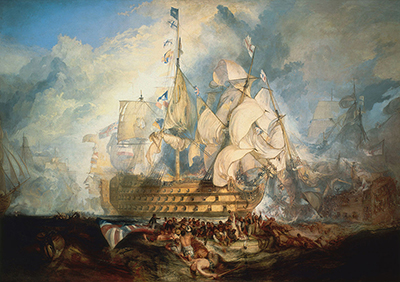The Battle of Trafalgar depicts the naval engagement that occurred on October 21st 1805 between the British Royal Navy, under Lord Admiral Nelson, and the Spanish-French alliance, led by Pierre-Charles Villeneuve.
Despite being outnumbered (27 ships for the British against 33 for their enemies), the British crushed their opponent’s fleet without losing a single of their own vessels in the process.
Lord Nelson himself was mortally wounded in the battle, but the outcome nonetheless established the vast superiority of the British Navy and effectively put to rest Napoleon’s ambition of invading Britain.
The Battle of Trafalgar was painted between 1822 and 1824 after having been commissioned by King George IV, and Joseph Mallord William Turner is thought to have drawn his inspiration by delving into studies on Admiral Nelson and sketches by fellow painter J.C. Shetky.
Despite this research, the painting soon became a subject of controversy due to alleged historical inaccuracies.
Turner seemed to have favoured artistic interpretation over veracity in his work, as indeed, experts and members of the British Navy themselves, pointed in particular to the following misrepresentations: The “Achille” ship had not caught fire, “Le Redoutable” had not sunk (at least not until the storm that raged 9 days later), and the mast of the “HMS Victory” had not been broken.
However, the error that arguably most irritated the painting’s detractors, was the fact that Nelson’s signal “England expects every man to do his duty” was notoriously sent out right before the beginning of the battle, whereas it can be seen in the painting at an advanced, if not final, stage of battle, at which point the signal would have read “Engage the enemy more closely”.
Turner spent eleven days attempting to address his critics by altering the painting, but his efforts were in vain and did not succeed in either satisfying or silencing them.
Turner was penalised as a result: “The Battle of Trafalgar” was finally exhibited at the Royal Navy Hospital, and not at St. James’ Palace, as had originally been intended.
Despite the historical inconsistencies, nearly 200 hundred years after the bitter controversy, the virtuosity of William Turner is still undisputed and “The Battle of Trafalgar” is today widely recognised as a masterpiece.




